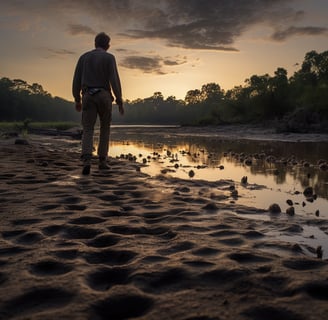Tracking and Field Techniques
An exploration of the skills and mindset


We embark on an exploration of the skills and mindset required to traverse the untamed realms where Bigfoot supposedly roams. By understanding the art of tracking and employing field techniques, we inch closer to the secrets that lie hidden within the natural world.
The Essence of Tracking
Tracking is both an ancient art and a modern science. The intuitive connection between tracker and trail, the ability to read the signs left behind by a creature, and the patience to piece together a story from the marks on the ground are fundamental aspects of tracking. This section introduces the essence of tracking and its significance in Bigfoot research.
Understanding Wildlife Signs
The wilderness is a canvas painted with the traces of its inhabitants. Learning to differentiate between tracks, scat, scratches on trees, broken vegetation, and other signs provides insights into the inhabitants of the area. By honing the skill of interpreting these signs, trackers can discern potential Bigfoot activity from the myriad of wildlife movements.
Navigating Terrain and Habitat
Bigfoot is rumored to inhabit a diverse range of landscapes, from dense forests to remote mountains. This section discusses how field researchers must adapt their tracking techniques to suit varying terrains and habitats. The interplay between knowledge of ecosystems and tracking expertise is essential for successful fieldwork.
The Art of Observation
At the heart of tracking lies the art of observation. Trained eyes recognize patterns in the landscape and irregularities that hint at hidden movement. Learning to observe without preconceived notions is critical to distinguishing genuine evidence from the noise of the wilderness.
Footprints and Gait Analysis
Footprints, if authentic, can provide invaluable information about Bigfoot's size, stride,
and gait. This section delves into the intricacies of analyzing footprints, measuring
dimensions, and using forensic techniques to determine authenticity. Understanding
how a creature moves through its environment can offer insights into its behaviour and
habits.
Photographic Documentation and Scale
Field researchers often rely on photographs to document findings. Learning to
photograph tracks, scat, and other evidence with a sense of scale is essential for
analysis. The inclusion of a reference object, such as a ruler or a common item, aids in
accurate measurement and verification.
Pattern Recognition and Behaviour Analysis
As trackers, researchers aim to decipher patterns in the landscape that indicate Bigfoot
movement or activity. This requires the ability to differentiate between natural
phenomena and potential evidence. Analyzing behaviour patterns, such as nesting
sites or feeding areas, contributes to a deeper understanding of the creature's
behaviour.
Casting and Preservation
When encountering particularly detailed or unique footprints, researchers may choose
to create casts for preservation and analysis. The next chapter discusses the casting
process, including materials and techniques, and highlights the importance of proper
documentation to prevent contamination of the original evidence.+